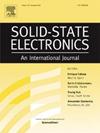Simulation analysis of resist flow in contact hole shrinkage and its impact on block copolymers
IF 1.4
4区 物理与天体物理
Q3 ENGINEERING, ELECTRICAL & ELECTRONIC
引用次数: 0
Abstract
A small size and tight pitch of contact holes (C/Hs) are crucial for achieving high device density and reducing manufacturing costs. Therefore, the increasing cost and limited resolution of C/Hs in extreme ultraviolet lithography (EUV) make shrinking C/Hs using the resist flow process (RFP) a promising technology. In this study, the Surface Evolver method, finite-element method (FEM), machine learning, and deep learning were applied to RFP to develop a physically accurate RFP model. Deep learning and machine learning proved effective for regression and classification in physical optimization problems. Additionally, self-consistent field theory (SCFT) was used to describe the self-assembly of cylinder-forming block copolymers (BCPs) confined in RFP C/Hs to achieve smaller C/H dimensions. A convolutional neural network (CNN) predicted RFP and BCP outcomes with an error margin of less than 5%, making it suitable for practical applications. This research paves the way for improved RFP shrinkage modeling of random C/Hs and the fabrication of smaller C/Hs.
接触孔收缩阻力流动及其对嵌段共聚物影响的模拟分析
小尺寸和紧凑的接触孔间距(C/Hs)是实现高器件密度和降低制造成本的关键。因此,极紫外光刻(EUV)中C/ h的成本不断上升,分辨率有限,因此利用抗蚀流工艺(RFP)缩小C/ h是一种很有前景的技术。在本研究中,将Surface Evolver方法、有限元方法(FEM)、机器学习和深度学习应用于RFP,以建立物理精确的RFP模型。深度学习和机器学习在物理优化问题的回归和分类中被证明是有效的。此外,自洽场理论(SCFT)用于描述限制在RFP C/H范围内的圆柱形嵌段共聚物(bcp)的自组装,以实现更小的C/H尺寸。卷积神经网络(CNN)预测RFP和BCP结果的误差小于5%,适合实际应用。本研究为改进随机C/ h的RFP收缩模型和制备更小的C/ h铺平了道路。
本文章由计算机程序翻译,如有差异,请以英文原文为准。
求助全文
约1分钟内获得全文
求助全文
来源期刊

Solid-state Electronics
物理-工程:电子与电气
CiteScore
3.00
自引率
5.90%
发文量
212
审稿时长
3 months
期刊介绍:
It is the aim of this journal to bring together in one publication outstanding papers reporting new and original work in the following areas: (1) applications of solid-state physics and technology to electronics and optoelectronics, including theory and device design; (2) optical, electrical, morphological characterization techniques and parameter extraction of devices; (3) fabrication of semiconductor devices, and also device-related materials growth, measurement and evaluation; (4) the physics and modeling of submicron and nanoscale microelectronic and optoelectronic devices, including processing, measurement, and performance evaluation; (5) applications of numerical methods to the modeling and simulation of solid-state devices and processes; and (6) nanoscale electronic and optoelectronic devices, photovoltaics, sensors, and MEMS based on semiconductor and alternative electronic materials; (7) synthesis and electrooptical properties of materials for novel devices.
 求助内容:
求助内容: 应助结果提醒方式:
应助结果提醒方式:


